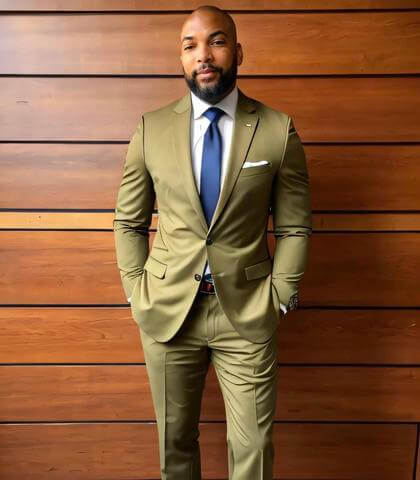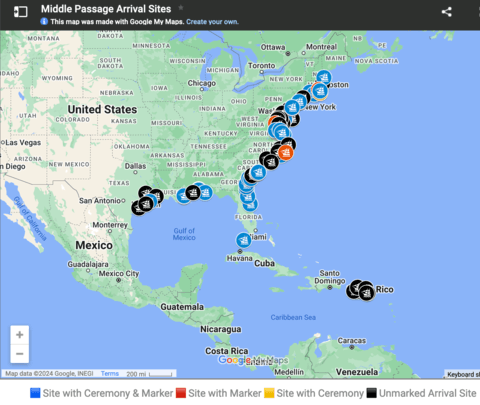Word to the Wise | Christopher Newman
by Anna De Cheke Qualls
There were nearly nearly 12 million Africans involved in the Middle Passage of the transatlantic human trade to the Americas. And there's a map that shows exactly where slaving vessels, or slave ships, landed.
The Middle Passage Ceremonies and Port Markers Project (MPCPMP), through community-led research has unearthed these sites over more than a decade. In 2023, the Mellon Foundation recognized MPCPMP for its transformative and engaging work through a three-year grant.
Through this award, History PhD student Christopher Newman landed the coveted role of Digital Researcher. At Howard, his research focuses on Nineteenth Century Creole (New Orleans) Voodoo as a form of slave resistance.
“In thinking about my ancestors and their connection to God and desires for liberation, I wanted to know they might have used traditional African indigenous religions as forms of rebellion and resistance against slavery. I wanted to research Voodoo because of its connection to the Haitian Revolution, and the continued stereotypes and misunderstandings it has, especially among Black people outside of New Orleans. Lastly, I wanted to understand how Voodoo was used as a form of resistance, and the racial components that led to its vilification,” says Newman.
At MPCPMP, Newman examines archives, online databases, survey shipping records to identify locations – mainly found along the Eastern portion of the United States, from Maine to Florida, Mississippi, Louisiana, Alabama, Texas, and Puerto Rico. Once identified, MPCPMP contacts respective communities to indicate that their city or town was a location where Africans arrived, and a remembrance ceremony is held to unveil a historic marker.
Although the project is primarily focused on the Atlantic and southern regions of the United States, Newman’s research ties directly into the Middle Passage region because Louisiana, and more specifically New Orleans, is an area where many enslaved men and women were transported across the ocean.
In addition to working with MPCPMP, Newman also works as a Community Liaison at the Caribbean Preservation Alliance. He assists in creating safe spaces of communication between Caribbean communities and African-American communities to preserve alliances between the two diasporas. This is often accomplished by hosting panel discussions, blog writing, speaking with community leaders on the issues facing the two communities, and developing cultural initiatives between African-Americans and Caribbean Americans or those living in the Caribbean.
“As someone who believes in the power of collective unity, working with an alliance that fosters unity, collaboration, and education is a tremendous opportunity,” remarks Newman.
Originally from Columbus, Ohio, Newman came to Howard because he wanted to experience academic life at an HBCU.
“I wanted to be surrounded by and supported by people who looked like me, may have shared experiences, and above all, I wanted to be part of the Black excellence that Howard creates,” he says.
What have you learned from the Middle Passage Project? Anything surprising? Perhaps facts you weren’t aware of?
One of the things I have learned is that enslaved Africans were not simply concentrated to specific regions or areas in America. For example, Texas was a location where slaving vessels arrived carrying enslaved men, women, and children. Also, I have learned that there were far more slave ships that arrived in America than most may know. It is hard to comprehend the sheer number of vessels that came to America and the hundreds of thousands of souls that were carried across the Atlantic. To really comprehend the magnitude of the Middle Passage, from a numbers perspective, is as sobering as it is captivating.
Where are you accessing the archives and resources for MPCPMP research?
Currently I am working on the area of Biloxi, Mississippi, and identifying the slaving vessels that arrived in the early to late 1770s. I am using various archival data to identify the names of these ships along with their captains, years of departure from Africa, where in Africa the vessels departed, the number of Africans aboard these ships at the time of departure, and the number of Africans that arrived once the ships landed in Biloxi. A tremendous archive that I am using is slavevoyages.org. I am also using books from my personal collection like Gwendolyn Midlo Hall’s Africans in Colonial Louisiana as a key point of reference.
Is there any overlap or synergy between MPCPMP and the Caribbean Preservation Alliance (and then your own research)?
I would not say that there is overlap or synergy between the Middle Passage Markers Project and the Caribbean Preservation Alliance because one is historical data while the other is contemporary community work. However, there is overlap with my own research and the Middle Passage Markers project because of the close connections between enslaved men, women, and children arriving in America, particularly Louisiana, and my curiosity on their spiritual and cultural connections to Africa.
What skills have you learned from each of the two roles?
With the Middle Passage Markers Project, I have learned how to interrogate the primary sources and how to condense that information down into a presentation that someone who does not attend a university or does not have an advanced degree in History can understand. This is important because one of the primary functions of the Middle Passage Markers Project is to create historical markers that briefly explain the history of the area where slaving vessels arrived. Making sure people can read and understand what is on the various markers is one of the most important skills for our project.
With the Caribbean Preservation Alliance, I have learned how to connect with other communities, develop ideas for programs that will bring these communities together, such as lectures and discussions, and creating informational data about different countries in the Caribbean for those who may not be aware of their rich culture and history.
What do you hope to do after completing your PhD?
My primary goal after completing my PhD is to begin teaching traditional African religions and how they relate to African Diaspora and Caribbean history.
How can folks follow the outcome of the Middle Passage Project? Or get involved? It seems like this work is so critically important.
You can follow the Middle Passage Markers Project on their website middlepassageproject.org or on Facebook at The Middle Passage Ceremonies and Port Markers Project.
A lot of research these days is interdisciplinary and collaborative, how has that played out in the Middle Passage Markers project? Have you been able to learn new skills from colleagues or inform the project with your background?
Collaboration and interdisciplinary research is key to my work on the Middle Passage Markers Project because everyone brings something different to the table and assists in making each site a success. I have a background in History, but I can also read French fluently, so that skill comes into play when translating information in French about vessels that arrived in New France (what is today Louisiana). Some are skilled in geography, while others can update the website with new site information including digital maps. While some of our backgrounds may be different, we all share a common bond in ensuring our history is preserved for future generations and that these voyages and arrivals will never be forgotten.
Anything else we should know?
I am a proud first-generation HBCU student. I currently serve as the President of the History Department Graduate Student Association. I have worked with other community organizations outside of Howard including Washington DC.’s African drumming scene. I am also a member of the Howard University chapter of Phi Alpha Theta, a member of the Black Doctoral Network, and several other academic and community organizations. Lastly, I am the owner of my own online apparel store called MadIntelligent Shirts & Apparel, where I sell clothing inspired by and for Black culture. HU! You Know!


